
“One small step for man, one giant leap for mankind.”
When American astronaut Neil Armstrong became the first person to set foot on the lunar surface on 21 July 1969, it was 22:56 in Houston, 05:56 in Paris, 07:56 in Moscow and 13:56 in Tokyo.
But what time was it on the Moon?
More than five decades later, the European Space Agency (ESA) is seeking to answer this question. This week, it reported that space organisations around the world are studying the best way to establish “a common lunar reference time,” an idea already outlined in November 2023 at a meeting in the Netherlands.
“Now a joint international effort is being launched to achieve this,” said Pietro Giordano, a navigation systems engineer at the space agency.
But the time set by clocks on Earth cannot be applied off the planet.
Euronews interviewed Francisco Diego, an astronomer at University College London, to better understand how time can be measured in space.
What is the equivalent of one hour on the Moon?
On Earth, time is measured in relation to the rotations on its own axis. They define what we know as night and day. One complete revolution is 24 hours and one circuit around the Sun (365 days) defines one year.
But the lunar cycle doesn’t work that way.
The way the Moon rotates means “the lunar day lasts 29-and-a-half Earth days. So, on the Moon we can see the Sun rise and set across a span of 14 days,” explained Francisco Diego.
“So, defining that time will also be important, as it will be done according to the height of the Sun above the horizon,” he added.
And it’s not just the length of the days. Clocks are another challenge.
According to the ESA, clocks tick faster on the Moon: they gain about 56 microseconds or millionths of a second per day. This is because they run slower in stronger gravitational fields, such as the Earth’s.
How can time be measured on the Moon?
The ESA is proposing an international agreement on a reference frame “similar to the role played on Earth by the International Terrestrial Reference Frame, which allows the consistent measurement of precise distances between points all over our planet.”
Diego agrees that a type of measurement, similar to that of the Earth’s meridians or time zones, should be followed.
“It would have to be based on the central meridian of the Moon, which I think is zero latitude, which is the latitude that corresponds to the vertical line that appears when the Moon is in the waning or waxing phase,” explained the astronomer. “And from there the time zone would be measured in degrees, but based on the altitude of the Sun, so people could figure out what the solar time is at that time.”

What time is it on the International Space Station?
One group of people who already know what it’s like to have to look at the clock and organise their time in Space are the astronauts on the International Space Station.
However, despite orbiting 354 kilometres above the Earth’s surface, they follow an Earth time zone, namely the Universal Time Coordinator (UTC) or Greenwich Prime Meridian, halfway between Houston and Moscow.
This has its drawbacks. “The International Space Station has a day that is 90 minutes long,” Diego points out. “They see the Sun rise and set 16 times in a day, in 24 hours.”
But it’s the most practical measure found so far, to maintain communications with Earth.
Who is going to decide lunar time?
In 1884, at the insistence of the United States, an international conference was held in Washington, DC, to decide “a meridian to be employed as a common zero of longitude and standard of time-reckoning throughout the globe.”
The result was the Greenwich meridian, which passes through the Royal Observatory in London, UK. It became the international standard for zero degrees longitude.
The ESA also wants an international agreement to set the way lunar time is measured.
“These are very dangerous missions that require a lot of help from all countries and we have to go as a unified humanity, exploring Space with the same regulations,” said Diego.
The astronomer thinks this type of agreement must be framed in the 1967 Space Treaty signed by UN member states. It includes how the exploration and use of the Moon must be carried out.
Why is it urgent to set the time on the Moon now?
The Moon is once again at the centre of ESA’s Space exploration efforts as it plans dozens of lunar missions over the next decade, including the construction of bases on its surface.
There is a “need to maintain communication between the Moon and Earth from all these missions […] There is going to be a need to agree on Greenwich Mean Time,” Diego explains.
“But on the other hand, once we already have many missions in orbit around the Moon from several countries, then communication with Earth takes a back seat and then it becomes more independent and that’s where lunar time is going to be very important.”
“Once we have established an operational time system for the Moon, we can continue to do the same for other planetary destinations,” the ESA stated.




